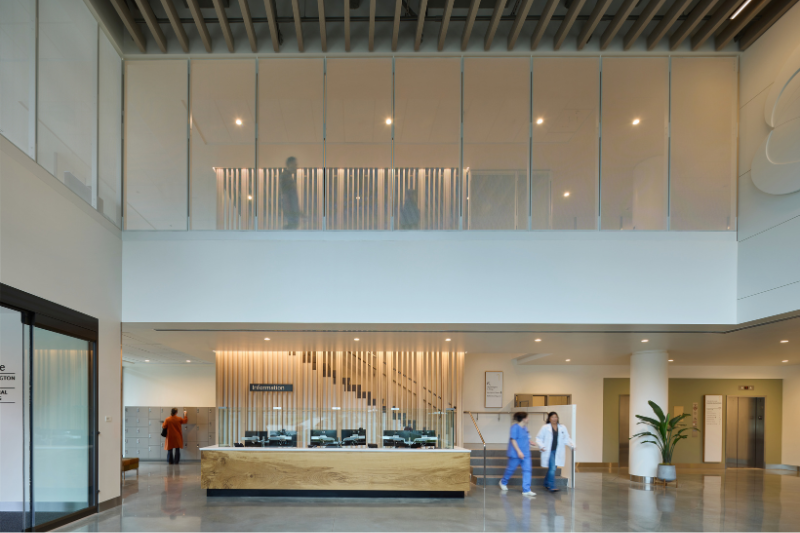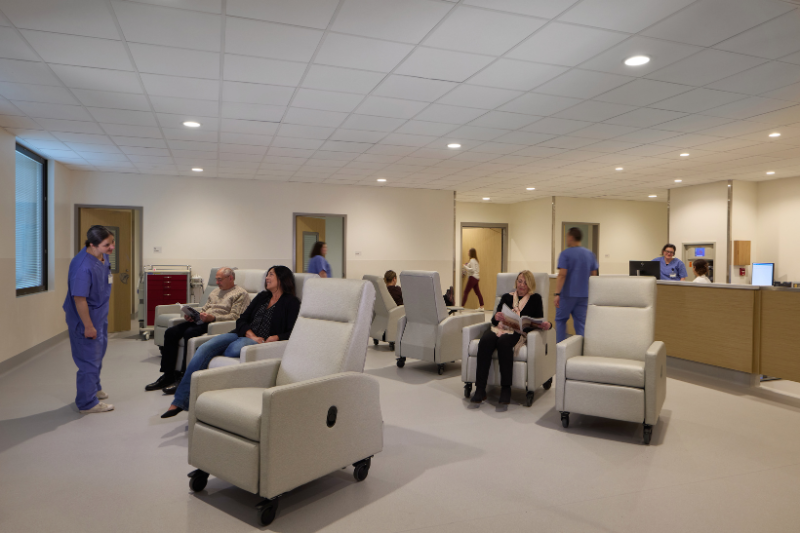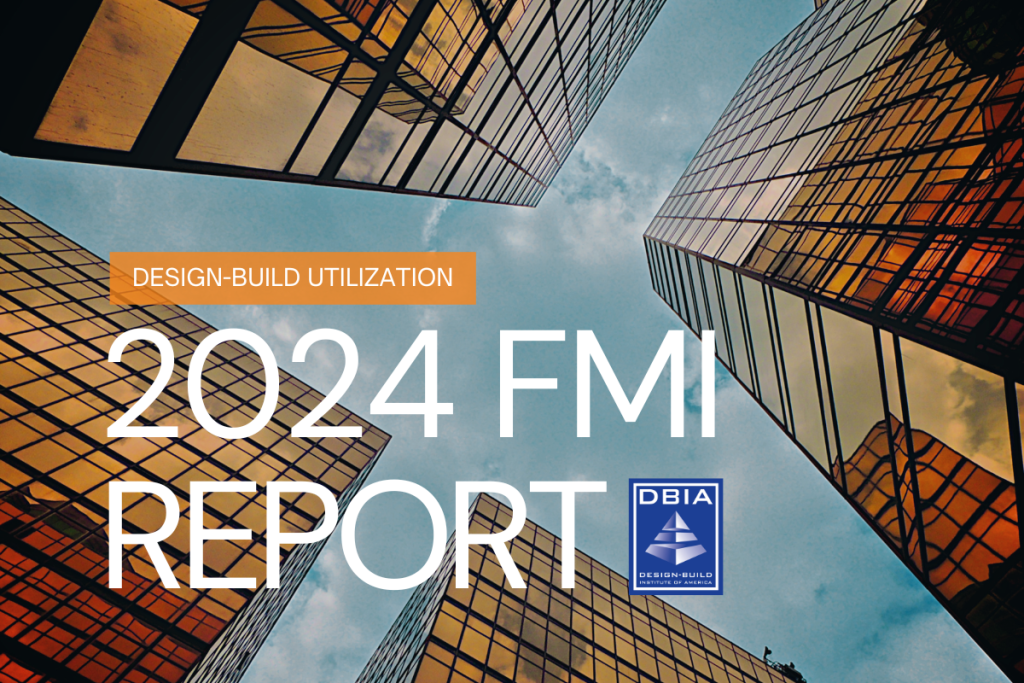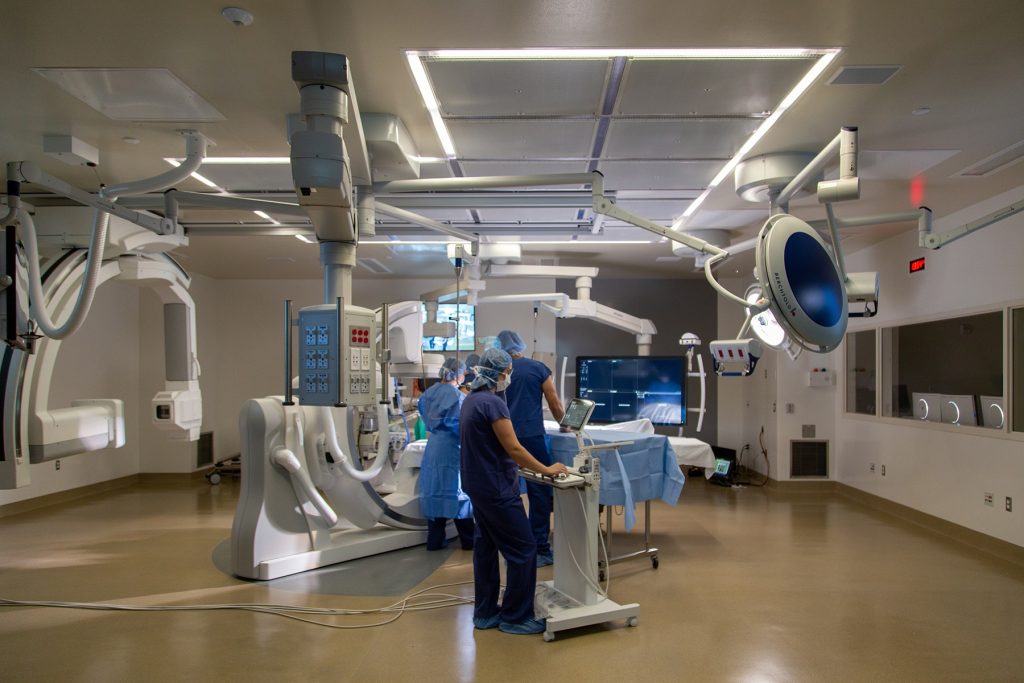A Conversation with Deb Sheehan, ACHE, LEED AP, DBIA, and Barbara Wagner, LEED AP, FDBIA
Lauren Zampella, Communications Manager, Clark Construction Group, contributed to this series.
Healthcare construction is evolving rapidly to meet the growing demands of patient care, technology integration and resilience. In this two-part series, we explore how design-build is transforming the industry with insights from industry leaders Deb Sheehan, ACHE, LEED AP, DBIA, and Barbara Wagner, LEED AP, FDBIA. Part one focused on the immediate impact of design-build on healthcare facilities, while part two looks ahead at how the method is future-proofing healthcare construction.
“We’re not just building facilities; we’re building the future of healthcare,” said DPR Construction’s Healthcare Market Strategy Leader Deb Sheehan, ACHE, LEED AP, EDAC, DBIA, reflecting on the challenges and opportunities facing today’s healthcare sector.
For industry leaders like Sheehan and Clark Construction Group Executive Vice President Barbara Wagner, LEED AP, FDBIA, the future of healthcare construction hinges on flexibility, resilience and innovation. From seismic retrofits in California to the rise of behavioral health and outpatient care, healthcare facilities must be designed to adapt in real time. Design-build is proving to be a critical tool in this transformation, allowing providers to meet today’s demands while preparing for an unpredictable future.
Future-Proofing Healthcare Construction
The future of healthcare is shifting toward outpatient and smaller clinical hub facilities such as Ambulatory Surgery Centers (ASCs) or specialty diagnostic centers, which aim to expand healthcare access to suburban and rural locations. At the same time, there’s an increasing need to focus on building resilient and future-proofed facilities that can last the next 100 years. Design-build is playing a crucial role in addressing these needs, creating environments that are not only adaptable to seismic events and extreme weather due to climate change but also to rising patient demands and advances in care options and availability.
One of the most pressing challenges for healthcare construction in California is seismic compliance, as hospitals across the state rush to meet the 2030 deadline set by the California Seismic Safety Act.

“Hospitals across the state are up against strict deadlines and complex regulations, and that’s where design-build really shows its strength,” said Wagner. “With progressive design-build (PDB), we can bring everyone in early to plan out these seismic upgrades, making sure our projects are completed on time with an eye to preparing these facilities for the next 100 years.”
Several large health systems and academic medical centers in the state have turned to PDB to manage seismic compliance and simultaneously address future-proofing concerns. The PDB procurement model, which has seen significant growth in the state over the past few years, supports greater flexibility in project delivery, leading to faster decision-making and better cost control.
Wagner explained, “The growth of progressive design-build in California shows just how effective this procurement method can be. More than just bringing design and construction teams together early, PDB allows for continuous collaboration, with Owners fully involved in key decisions throughout the project. This open and iterative approach helps hospitals navigate complex challenges like seismic compliance while maintaining transparency, managing costs effectively and driving innovation.”
As hospitals across California adopt PDB for seismic retrofits and modernization projects, the method continues to prove its value in both regulatory compliance and long-term resilience planning. Beyond California, states like Texas are also seeing movement toward design-build as healthcare providers embrace its flexibility to adapt to future patient needs.
Navigating the Pandemic Legacy and Shifting Needs
The COVID-19 pandemic has left an enduring impact on healthcare construction, shifting priorities for many healthcare providers. With a growing focus on behavioral health, preventative care and community wellness, facilities are being reimagined to meet immediate needs and long-term challenges equitably. Design-build has emerged as a crucial delivery method for adapting to these new realities.
The University of Washington (UW) Behavioral Health Teaching Facility is a prime example of how healthcare systems are evolving to provide mental health resources to the local community.
“Behavioral health and mental wellness are at the forefront of healthcare planning now. The pandemic showed us just how critical it is to have adaptable healthcare environments,” Wagner said. “With design-build, we can create spaces that are prepared not only for today’s demands but also for whatever might come next — whether it’s another public health crisis or a change in clinical services.”
UW’s Center for Behavioral Health and Learning was designed to provide safe, high-quality patient care in a cost-effective and efficient manner. Delivered through PDB, the facility sets a new benchmark for behavioral health by prioritizing adaptability and patient-centered design.
The new building expands the existing hospital and serves as a community hub for mental health advocacy. Its top three floors house highly flexible behavioral health inpatient units, designed to accommodate a wide range of patient needs and treatment approaches.

This flexibility was made possible through the progressive design-build approach. Early and continuous collaboration between contractors, designers and healthcare professionals allowed the team to adapt the design in real-time. This resulted in patient-centered features such as increased natural lighting, open communal areas that foster social interaction and adaptable patient rooms that can be reconfigured to support evolving care models. Unlike traditional delivery methods, design-build’s integrated process enabled rapid problem-solving and seamless adjustments, ensuring the facility could meet both current and future behavioral health care demands.
Beyond patient care, the Center also serves as a training ground for the next generation of behavioral health professionals. It houses an interdisciplinary training and workforce development program designed to prepare and support future healthcare providers in delivering comprehensive mental health care.
Looking Ahead: The Future of Healthcare Construction
As design-build continues to gain traction across various sectors, its role in healthcare construction is also on the rise. According to the 2024 FMI Design-Build Utilization Study, design-build is anticipated to account for $2.6 trillion of construction spending in assessed segments over the 2024 – 2028 forecast period, representing over 47% of total U.S. construction spending by 2028. Healthcare, while accounting for 6% of this spending, is expected to grow at a compound annual growth rate (CAGR) of 4.6%, reflecting increasing demand for flexible and resilient healthcare environments.
This growth represents approximately $119 billion in construction spending for healthcare over the 2024 – 2028 forecast period. While smaller in comparison to other sectors, the steady rise in healthcare construction emphasizes the evolving needs of the industry, particularly as hospitals, outpatient centers and specialized facilities pivot toward more adaptable and patient-focused designs.
“We’re seeing growth across the board,” said Sheehan. “Design-build allows healthcare providers to tackle the complex challenges of today while planning for the future — whether that’s integrating telehealth technology, meeting seismic compliance standards or creating adaptable spaces for evolving patient care models.”
As healthcare construction continues to rise — particularly with the growth of outpatient facilities and smaller healthcare hubs — the flexibility of design-build is more crucial than ever.
Providers are increasingly turning to design-build for its ability to deliver projects on time, within budget and with the flexibility to meet future demands. With healthcare needs constantly shifting, design-build’s adaptable approach is proving essential for navigating an uncertain future in healthcare real estate development, allowing providers to rapidly respond to evolving care models, escalating cost of care and expanded patient demand.
Looking ahead, design-build is poised to lead the transformation of healthcare facilities with innovation, cost certainty, speed and quality as key drivers. Healthcare will no doubt continue its shift toward outpatient care and smaller, more adaptable and affordable facilities, making design-build critical in helping the industry navigate these changes efficiently and effectively.
UW Center for Behavioral Health and Learning Stats:

- Location: University of Washington, Seattle, WA
- Completion: 2024
- Scope: Inpatient and outpatient care for individuals with behavioral health needs in addition to a training site for the next generation of health and behavioral healthcare providers
- Key Techniques: Progressive design-build, early contractor involvement, flexible units to adapt to client needs
- Challenge: Designed during the pandemic. Design vision created a space that promotes well-healing and learning in a non-institutional setting
Get the New 2024 FMI Design-Build Utilization Study

- Full FMI Report: Download the free full report.
- Design-Build Delivers Podcast: The February 2025 episode of the Design-Build Delivers Podcast drops Monday, Feb. 10. FMI’s Emily Beardall explores the results of the report and talks about design-build’s future. Available wherever you listen to podcasts.
Learn More About Progressive Design-Build

- Progressive Design-Build Deeper Dive: Download the resource for free.
- PDB Webinars and Education: Explore our schedule for dates.
- Design-Build Delivers Podcast: Listen to The Human Side of Progressive Design-Build with Geoff Neumayr (August 2024).
More on Healthcare Construction from Around the Industry
- U.S. Healthcare Building Sector Trends and Innovations for 2024-2025, Building Design+Construction, Aug. 8, 2024.
- Healthcare Construction a Key Part of U.S. Infrastructure, Construction Dive, Dec. 10, 2024.
- Construction of Healthcare Facilities Expected to Surge in 2025, For Construction Pros, Jan. 28, 2025.
- Four Key Expert Healthcare Construction Predictions for 2025 and Beyond, Healthcare Construction+Operations, Jan. 30, 2025.
Missed part one of this series? Be sure to read how design-build is meeting today’s healthcare construction challenges with faster delivery, flexibility and collaboration.
Meet the Experts

Deb Sheehan, ACHE, LEED AP, DBIA
Healthcare Market Strategy Leader, DPR Construction
With over 30 years of experience, Deb Sheehan is recognized for her evidence-based project delivery approach, overseeing more than $9.5 billion in design solutions for the built environment. She champions strategies that shape industry trends and anticipate future solutions. Sheehan’s work has been featured in The Wall Street Journal, Fast Company and Modern Healthcare, and she frequently contributes to top industry publications like Modern Healthcare Magazine and Becker’s Hospital Review.
Sheehan has earned numerous accolades, including Building Design & Construction’s 40-under-40 award and recognition as one of the Healthcare Design Top Twenty Making a Difference in Healthcare. She also serves on the Design-Build Institute of America’s National Board of Directors and holds DBIA, LEED and Evidence-Based Design certifications.
Fun Fact:
In addition to her work in healthcare, Sheehan has advised international clients like the Turkish Ministry of Health on groundbreaking innovations in project delivery.
Barbara Wagner, LEED AP, FDBIA
Executive Vice President, Clark Construction Group
With nearly four decades of experience in healthcare construction, Barbara Wagner has led some of the country’s most complex healthcare projects, including the Naval Hospital at Camp Pendleton, Stanford Adult Hospital and Ventura County Medical Center Hospital Replacement Wing.
As Executive Vice President at Clark, Wagner spearheads the company’s healthcare strategy, working closely with health systems to track emerging trends and technologies. Her leadership is grounded in deploying design-build best practices to solve the challenges unique to healthcare construction.
In 2023, Wagner was named a Design-Build Institute of America Fellow, the highest level of DBIA Certification, recognizing her as one of the nation’s most accomplished design-build professionals.
Fun Fact:
Outside of her work, Wagner is an advocate for local community wellness initiatives and enjoys volunteering with healthcare advocacy groups in her free time.

Additional Contributor

Lauren Zampella
As communications manager at Clark Construction, Lauren Zampella promotes the Clark brand on the West Coast, aligning regional goals with corporate strategy. She is also responsible for corporate branding, ensuring marketing materials and content meet standards.
